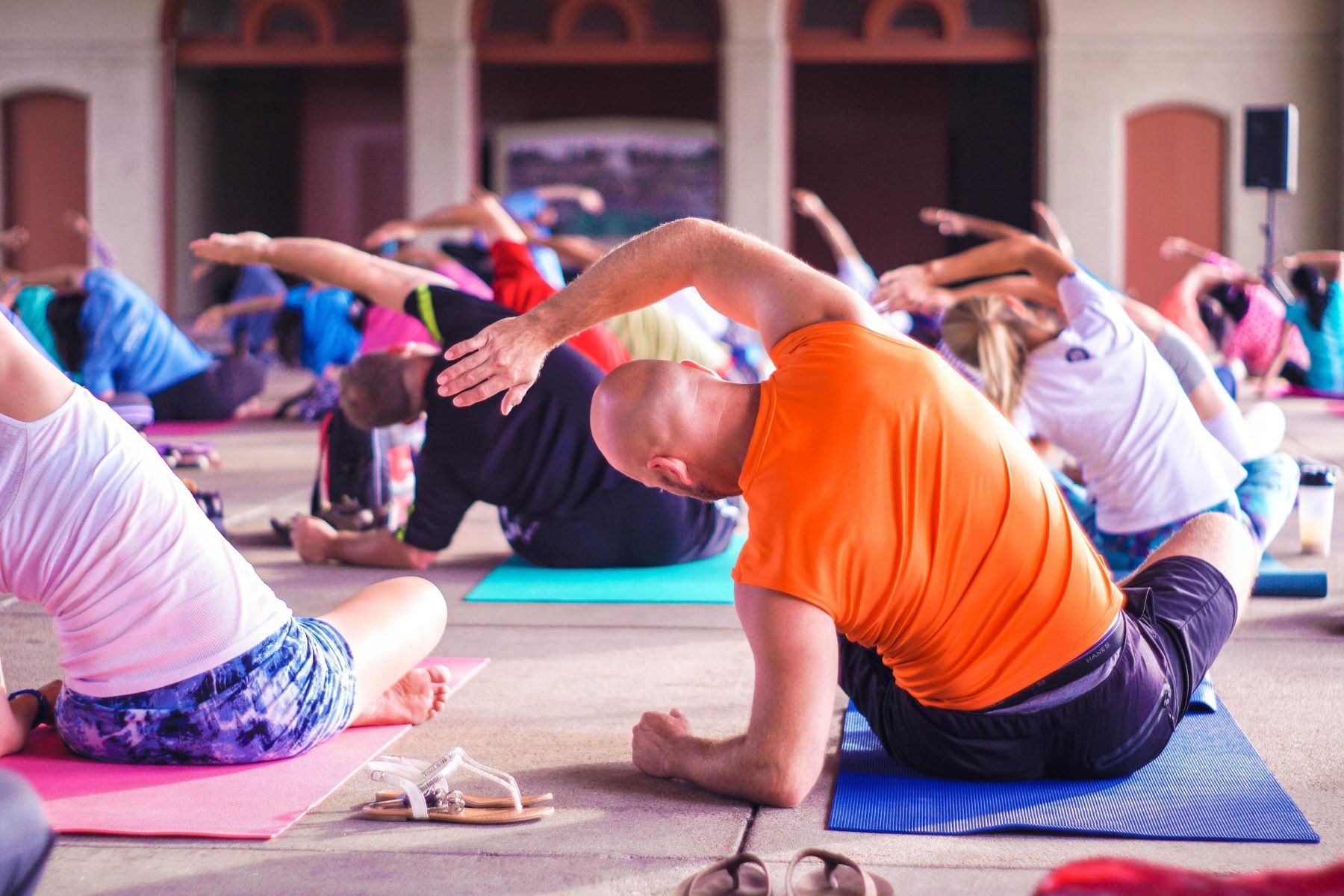Home>Misc>Featured>What Activities Can Develop Cardiorespiratory Endurance


Featured
What Activities Can Develop Cardiorespiratory Endurance
Modified: January 22, 2024
Improve your cardiorespiratory endurance with our featured activities! Take the quiz on Quizlet to test your knowledge and learn effective ways to develop your endurance.
Introduction
Welcome to our comprehensive guide on activities that develop cardiorespiratory endurance. Cardiovascular fitness is a fundamental aspect of overall health and well-being. Engaging in activities that improve cardiorespiratory endurance can have numerous benefits, ranging from increased energy levels to a reduced risk of chronic diseases. Whether you are an athlete looking to enhance your performance or someone simply wanting to improve your fitness level, this article will provide valuable insights into the types of activities that can help you develop cardiovascular endurance.
Cardiorespiratory endurance refers to the ability of the heart, lungs, and circulatory system to efficiently supply oxygen and nutrients to the working muscles during prolonged periods of physical activity. It plays a crucial role in enhancing the body’s capacity to perform tasks that require sustained effort, such as running, cycling, or swimming, without experiencing fatigue or excessive exertion.
Regular participation in activities that improve cardiorespiratory endurance leads to adaptations in the cardiovascular system, including an increase in stroke volume (the amount of blood pumped out of the heart with each beat) and a decrease in resting heart rate. These adaptations not only improve the efficiency of the cardiovascular system but also enhance overall fitness and performance.
Developing cardiorespiratory endurance is important for people of all ages and fitness levels. It can benefit athletes aiming to enhance their performance in endurance sports, individuals looking to lose weight or manage their body composition, and even those simply seeking to improve their overall health and well-being. So, whether you are a professional athlete or a beginner just starting your fitness journey, understanding the activities that can help develop cardiorespiratory endurance is key to achieving your goals.
Definition of Cardiorespiratory Endurance
Cardiorespiratory endurance is a measure of the body’s ability to sustain prolonged physical activity that requires the efficient functioning of the heart, lungs, and circulatory system. It is often referred to as cardiovascular endurance or aerobic fitness. The term “cardiorespiratory” combines the words “cardio” (heart) and “respiratory” (lungs), highlighting the importance of these two systems in delivering oxygen and nutrients to the working muscles.
In simple terms, cardiorespiratory endurance represents the stamina or staying power of an individual during activities that elevate the heart rate for an extended period. The higher the individual’s cardiorespiratory endurance, the longer they can sustain moderate to high-intensity exercise without experiencing excessive fatigue or breathlessness.
Cardiorespiratory endurance is typically assessed using various tests, such as the 1.5-mile run, the maximal oxygen consumption (VO2 max) test, or the beep test. These tests measure the body’s ability to efficiently transport and utilize oxygen during physical exertion. A higher VO2 max value indicates a greater capacity for aerobic performance and reflects a higher level of cardiorespiratory endurance.
Improving cardiorespiratory endurance involves training and conditioning the cardiovascular and respiratory systems to adapt and work more efficiently. Regular aerobic exercise, which challenges and elevates the heart rate, is the primary method for developing cardiorespiratory endurance. Examples of aerobic activities include running, cycling, swimming, brisk walking, dancing, and playing sports such as soccer or basketball.
It is important to note that cardiorespiratory endurance is specific to each individual and can be influenced by factors such as genetics, age, sex, and overall fitness level. Additionally, cardiorespiratory endurance is not the same as muscular strength or power, which involve different physiological processes and systems.
By understanding the definition and importance of cardiorespiratory endurance, individuals can tailor their exercise routines and training programs to effectively improve their cardiovascular fitness and overall health.
Importance of Developing Cardiorespiratory Endurance
Developing cardiorespiratory endurance through regular physical activity has numerous benefits for overall health and well-being. Here are some key reasons why it is important to prioritize the improvement of cardiorespiratory endurance:
- Enhanced Physical Performance: Developing cardiorespiratory endurance allows individuals to perform physical activities at higher intensities and for longer durations without experiencing fatigue. This is particularly beneficial for athletes and individuals participating in endurance sports, such as running, cycling, or swimming.
- Increased Energy Levels: Improved cardiorespiratory endurance enhances the delivery of oxygen and nutrients to the working muscles, which leads to increased energy production. This results in more energy throughout the day, allowing individuals to handle daily tasks more efficiently and with greater vigor.
- Weight Management and Body Composition: Engaging in activities that improve cardiorespiratory endurance can contribute to weight loss and the maintenance of a healthy body composition. Aerobic exercise burns calories and promotes fat loss, helping individuals achieve their weight management goals.
- Reduced Risk of Chronic Diseases: Regular aerobic exercise has been linked to a decreased risk of chronic conditions such as cardiovascular disease, high blood pressure, type 2 diabetes, and certain types of cancer. Improving cardiorespiratory endurance helps to strengthen the heart, improve blood circulation, and support overall cardiovascular health.
- Improved Mental Health: Engaging in activities that boost cardiorespiratory endurance can have a positive impact on mental health. Aerobic exercise releases endorphins, which are natural mood elevators, and can reduce symptoms of anxiety and depression. It also promotes better sleep and helps manage stress levels.
- Increase in Longevity: Studies have shown that individuals with higher levels of cardiorespiratory endurance tend to live longer and maintain a higher quality of life as they age. Regular physical activity that improves cardiovascular fitness can help prevent age-related decline and improve overall health span.
By prioritizing the development of cardiorespiratory endurance, individuals can enjoy these wide-ranging benefits and lead a healthier, more active, and fulfilling life.
Factors Affecting Cardiorespiratory Endurance
Several factors can influence an individual’s cardiorespiratory endurance. Understanding these factors can help individuals tailor their training and make informed decisions to improve their cardiovascular fitness. Here are some key factors that can affect cardiorespiratory endurance:
- Genetics: Genetic factors can influence an individual’s baseline cardiorespiratory endurance. Some individuals may naturally have a higher aerobic capacity or a more efficient cardiovascular system due to genetic predispositions.
- Age: Cardiorespiratory endurance tends to decline with age, primarily due to age-related changes in the cardiovascular and respiratory systems. However, regular aerobic exercise can slow down this decline and help maintain or improve endurance levels regardless of age.
- Gender: Generally, males have a higher cardiorespiratory endurance compared to females. This is due to physiological differences, including differences in muscle mass, hormonal composition, and oxygen-carrying capacity. However, it’s important to note that individual variations exist, and both males and females can improve their cardiorespiratory endurance through training.
- Body Composition: Body fat percentage and muscle mass can influence cardiorespiratory endurance. Excess body fat can impede endurance performance, as it places additional stress on the cardiovascular system. On the other hand, individuals with a higher proportion of lean muscle mass may have an advantage, as muscles require more oxygen and can contribute to increased aerobic capacity.
- Training and Exercise History: The level of physical activity and training history of an individual can significantly impact their cardiorespiratory endurance. Regular aerobic exercise and consistent training improve cardiovascular adaptations and enhance endurance over time.
- Overall Fitness Level: The overall fitness level of an individual, including muscular strength, flexibility, and agility, can influence cardiorespiratory endurance as these factors work together to support physical performance.
- Living Environment: Environmental factors such as altitude, temperature, and humidity can affect cardiorespiratory endurance. Training at higher altitudes can stimulate adaptation and improve endurance capacity, while extreme temperatures and high humidity levels can increase the metabolic demand during exercise, impacting endurance performance.
- Health Conditions and Medications: Certain health conditions, such as heart or lung diseases, may limit cardiorespiratory endurance. Similarly, medications that affect heart rate, blood pressure, or oxygen uptake can influence endurance performance. It is important to consult with a healthcare professional for guidance if you have any underlying health conditions or are taking medications.
While these factors may influence cardiorespiratory endurance to some extent, it’s essential to remember that improvements can still be achieved through regular exercise and appropriate training strategies. A consistent and progressive approach to training can help individuals overcome these factors and optimize their cardiovascular fitness.
Types of Activities that Develop Cardiorespiratory Endurance
There are numerous types of activities that can effectively develop cardiorespiratory endurance. The key is to engage in aerobic exercises that elevate the heart rate and challenge the cardiovascular system. Here are some examples of activities that can help improve your endurance:
- Running and Jogging: Running and jogging are excellent activities for developing cardiorespiratory endurance. Whether you prefer outdoor running or using a treadmill, these activities engage large muscle groups and elevate the heart rate, promoting cardiovascular adaptations over time.
- Cycling: Cycling, whether on a stationary bike or outdoors, is a low-impact activity that provides an effective cardiovascular workout. It targets the lower body muscles while improving cardiovascular fitness and endurance.
- Swimming: Swimming is a full-body workout that engages all major muscle groups, making it an excellent choice for improving cardiovascular endurance. It is also a low-impact activity, making it suitable for individuals with joint issues.
- Brisk Walking: Brisk walking is a beginner-friendly activity that can gradually improve cardiorespiratory endurance. It is a low-impact exercise that can be easily incorporated into daily routines, such as walking to work or taking brisk walks during breaks.
- Dancing: Dancing is not only a fun and enjoyable activity but also a great way to improve cardiorespiratory endurance. Whether it’s Zumba, hip-hop, or salsa, dancing can get your heart rate up and challenge your cardiovascular system.
- Aerobic Classes: Participating in group aerobic classes, such as step aerobics, kickboxing, or aerobics routines, can provide a structured and motivating way to improve cardiorespiratory endurance. These classes often incorporate high-intensity intervals, which further challenge the cardiovascular system.
- Sports: Engaging in sports such as soccer, basketball, tennis, or volleyball involves a combination of aerobic activity and skill development. Sports can provide a fun and competitive way to improve cardiorespiratory endurance while enjoying the social aspect of team play.
- Interval Training: Interval training involves alternating periods of high-intensity exercise with recovery periods. This type of training challenges the cardiovascular system by pushing it to work harder during intense intervals, leading to improvements in endurance.
It’s important to choose activities that you enjoy and that can be incorporated into your regular routine. Aim for at least 150 minutes of moderate-intensity aerobic exercise or 75 minutes of vigorous-intensity aerobic exercise per week, as recommended by health guidelines.
Remember to start slowly and gradually increase the intensity and duration of your chosen activities. This will allow your body to adapt and prevent overexertion or injury. Consulting with a fitness professional or coach can also help you develop a customized training plan based on your fitness level and goals.
Endurance Training Principles
When it comes to developing cardiorespiratory endurance, incorporating certain training principles can maximize your progress and prevent plateaus. Here are some key principles to keep in mind:
- Progressive Overload: Gradually increase the intensity, duration, or frequency of your workouts over time. This progressive overload principle challenges your cardiovascular system and promotes adaptations, leading to improvements in endurance. Start with a manageable workload and gradually increase it to avoid overexertion or injury.
- Variety: Incorporate a variety of activities and training modalities into your routine to work different muscle groups and challenge your cardiovascular system in different ways. This prevents boredom and helps prevent overuse injuries by avoiding repetitive movements.
- Interval Training: Include interval training in your workouts. This involves alternating periods of higher-intensity exercise with lower-intensity recovery periods. Interval training is an effective way to improve cardiorespiratory endurance as it pushes your body to work at higher intensities than steady-state exercise.
- Long Slow Distance (LSD) Training: In addition to higher-intensity workouts, incorporate longer, slower distance sessions into your training plan. These longer workouts at a lower intensity help build the foundation of cardiovascular endurance and improve the efficiency of energy utilization.
- Rest and Recovery: Allow for proper rest and recovery between workouts. Rest days are essential for your body to repair and grow stronger. Overtraining can lead to decreased performance and increased risk of injuries, so listen to your body and prioritize recovery.
- Consistency: Regularity is key when it comes to developing cardiorespiratory endurance. Aim for consistent workouts throughout the week rather than sporadic intense sessions. This allows your body to adapt and build upon previous efforts.
- Proper Nutrition: Fuel your body with a balanced diet that supports your training goals. Adequate hydration, quality carbohydrates, lean proteins, and healthy fats are important for sustaining energy levels and supporting optimal cardiovascular health.
- Periodization: Consider implementing a periodized training plan, which involves dividing your training program into specific phases with varying intensities and focuses. This helps prevent plateaus and optimizes performance improvements over the long term.
Remember to listen to your body and adjust your training as needed. If you experience excessive fatigue, pain, or any concerning symptoms, it is important to seek guidance from a healthcare professional or qualified fitness coach.
By following these endurance training principles and staying consistent with your workouts, you can effectively develop your cardiorespiratory endurance and achieve your fitness goals.
Sample Exercises and Workouts for Cardiorespiratory Endurance
When it comes to improving cardiorespiratory endurance, incorporating a variety of exercises and workouts is key. Here are some sample exercises and workouts that can help you develop your cardiovascular fitness:
- Interval Running: Head to a local track or find a suitable outdoor route. Start with a warm-up jog for 5 minutes, and then alternate between running at a challenging pace for 1 minute and recovering with a slower pace or walking for 1-2 minutes. Repeat this cycle for 20-30 minutes, gradually increasing the number of intervals as your fitness improves.
- Stationary Bike Intervals: Hop on a stationary bike and warm up by cycling at a comfortable pace for 5 minutes. Then, alternate between high-intensity cycling for 1 minute and a relaxed pace for 2 minutes. Repeat this cycle for 20-30 minutes. Adjust the resistance and speed as necessary to challenge your cardiovascular system.
- Swim Intervals: Head to the pool and start with a few laps of easy swimming to warm up. Then, swim a set distance at a moderate to high intensity, followed by a recovery lap. Repeat this cycle for a specified number of sets or a certain time duration. Gradually increase the distance or the number of sets over time to continuously challenge your endurance.
- Circuit Training: Create a circuit that includes a series of exercises targeting different muscle groups, such as jumping jacks, burpees, mountain climbers, squat jumps, and high knees. Perform each exercise for a set period of time (e.g., 30 seconds) and then transition to the next exercise without resting. Complete 3-4 rounds of the circuit with minimal rest between exercises and rounds to keep your heart rate elevated.
- Hiking or Trail Running: Take advantage of nature and find a hiking trail or a scenic area suitable for trail running. The varied terrain and inclines will challenge your cardiovascular system while providing a refreshing and engaging workout.
- Dance Aerobics: Join a dance aerobics class or follow online dance workouts that keep you moving and grooving. Dance workouts offer a fun and enjoyable way to improve your cardiorespiratory endurance while learning new dance moves.
Remember, these are just a few examples, and you can customize your workouts based on your fitness level, preferences, and available resources. The key is to choose activities that elevate your heart rate and challenge your cardiovascular system consistently.
It is also important to warm up properly before engaging in any high-intensity workouts and cool down afterward to gradually bring your heart rate back to normal. Pay attention to your body and adjust the intensity or duration of the exercises as needed.
Consider consulting with a fitness professional to design a personalized training plan that aligns with your goals and ensures proper form and technique during your workouts.
Benefits of Improved Cardiorespiratory Endurance
Improving cardiorespiratory endurance through regular aerobic exercise and training offers a multitude of benefits for both physical and mental well-being. Let’s explore some of the key benefits that come with enhancing your cardiovascular fitness:
- Increased Stamina: Improved cardiorespiratory endurance enhances your stamina and allows you to perform physical activities for longer periods without feeling fatigued. Whether it’s running, swimming, or playing sports, you’ll have the energy and endurance to keep going.
- Efficient Oxygen Delivery: Enhancing your cardiovascular fitness improves the efficiency of your heart, lungs, and blood vessels, enabling them to deliver oxygen and nutrients more effectively to your muscles. This means increased endurance, reduced breathlessness, and improved overall performance.
- Weight Management: Regular cardio exercise aids in weight management by burning calories and promoting fat loss. Engaging in activities that improve cardiorespiratory endurance can help you achieve and maintain a healthy weight, as well as reduce the risk of obesity-related health conditions.
- Heart Health: Improved cardiorespiratory endurance strengthens the heart muscle and improves its efficiency. This reduces the risk of cardiovascular diseases such as heart attack, stroke, and high blood pressure. Regular aerobic exercise can also lower LDL (bad) cholesterol levels and increase HDL (good) cholesterol levels, further benefiting heart health.
- Mental Health: Engaging in activities that boost cardiovascular endurance has a positive impact on mental health. Aerobic exercise releases endorphins, which improve mood, reduce anxiety and depression, and promote a sense of well-being. It can also boost cognitive function and improve sleep quality.
- Improved Respiratory Function: Enhancing your cardiorespiratory endurance improves the efficiency of your respiratory system, increasing lung capacity and oxygen uptake. This can result in improved respiratory health and performance, particularly during physical activities.
- Increased Energy Levels: Regular participation in activities that improve cardiorespiratory endurance boosts energy levels by enhancing the delivery of oxygen and nutrients to your muscles. You’ll experience greater vitality throughout the day, making it easier to tackle daily tasks and activities.
- Longevity and Quality of Life: Studies have shown that individuals with higher levels of cardiorespiratory endurance tend to live longer and enjoy a higher quality of life. By improving your cardiovascular fitness, you can increase your life expectancy and reduce the risk of age-related decline and chronic diseases.
The benefits of improved cardiorespiratory endurance extend far beyond physical health, positively impacting various aspects of your overall well-being. From increased stamina and energy to enhanced mental health and longevity, committing to regular aerobic exercise and developing your cardiovascular fitness can truly transform your life.
Tips for Enhancing Cardiorespiratory Endurance
If you’re looking to enhance your cardiorespiratory endurance, here are some helpful tips to keep in mind:
- Choose Activities You Enjoy: Engage in activities that you find enjoyable and that align with your interests. This will increase your motivation and make it more likely for you to stick with your exercise routine in the long run.
- Start Slowly and Progress Gradually: If you’re new to exercise or returning after a break, start with low to moderate intensity workouts and gradually increase the duration and intensity over time. This approach helps prevent overexertion and reduces the risk of injury.
- Mix Up Your Workouts: Incorporate a variety of aerobic activities into your routine to work different muscle groups and challenge your cardiovascular system in different ways. This helps prevent boredom and ensures a well-rounded approach to improving your endurance.
- Include Interval Training: Incorporate interval training into your workouts, alternating between higher-intensity periods and recovery periods. This method promotes cardiovascular adaptations and boosts your endurance more effectively than steady-state workouts alone.
- Consistency is Key: Aim for regular exercise sessions to build and maintain your cardiorespiratory endurance. Strive for at least 150 minutes of moderate-intensity aerobic exercise or 75 minutes of vigorous-intensity aerobic exercise each week, spread across several days.
- Stay Hydrated: Proper hydration is crucial for optimal cardiovascular performance. Drink water before, during, and after your workouts to maintain hydration levels and support your endurance.
- Gradually Increase Intensity: As your fitness improves, progressively increase the intensity or duration of your workouts. This ensures ongoing improvements in cardiorespiratory endurance and helps prevent plateaus.
- Listen to Your Body: Pay attention to your body’s signals and adjust your workouts accordingly. If you feel excessively fatigued or experience pain or discomfort, take a rest day or modify your exercise intensity to allow for proper recovery.
- Get Adequate Rest: Allow your body enough time to rest and recover between workouts. This allows for muscular repair and adaptation, helping you perform better in subsequent workouts.
- Track and Monitor Your Progress: Keep a record of your workouts and track your progress over time. This can help you stay motivated and allow you to see how far you’ve come in improving your cardiorespiratory endurance.
Remember, always consult with a healthcare professional before starting any new exercise program, especially if you have any underlying health conditions or concerns.
By following these tips and staying committed to your cardiorespiratory endurance training, you can make significant strides in improving your endurance levels and achieving your fitness goals.
Conclusion
Developing cardiorespiratory endurance is essential for improving overall fitness, enhancing performance, and maintaining optimal health. By engaging in activities that challenge the cardiovascular system and following key principles of endurance training, you can significantly improve your endurance levels and reap a wide range of benefits.
From increased stamina and improved energy levels to a reduced risk of chronic diseases and enhanced mental well-being, the advantages of improving cardiorespiratory endurance are numerous. Regular aerobic exercise, such as running, cycling, swimming, dancing, and participating in sports, can help you achieve your fitness goals and boost your cardiovascular fitness.
Remember to start slowly and progress gradually, allowing your body to adapt to increased demands. Incorporate interval training, variation, and proper rest and recovery into your workouts for optimal results. Consistency and consistency are key; aim for regular exercise sessions to build and maintain your cardiorespiratory endurance.
Always listen to your body, adjust your workouts as needed, and consult with a healthcare professional if you have any concerns or underlying health conditions. Keeping track of your progress and staying motivated will help you stay on track and continue making improvements.
So, lace up your shoes, grab your swimsuit, or dance to the beat – embark on the journey to improve your cardiorespiratory endurance. With the right activities, training principles, and dedication, you’ll be amazed at the transformation you can achieve in your endurance levels and overall well-being.









